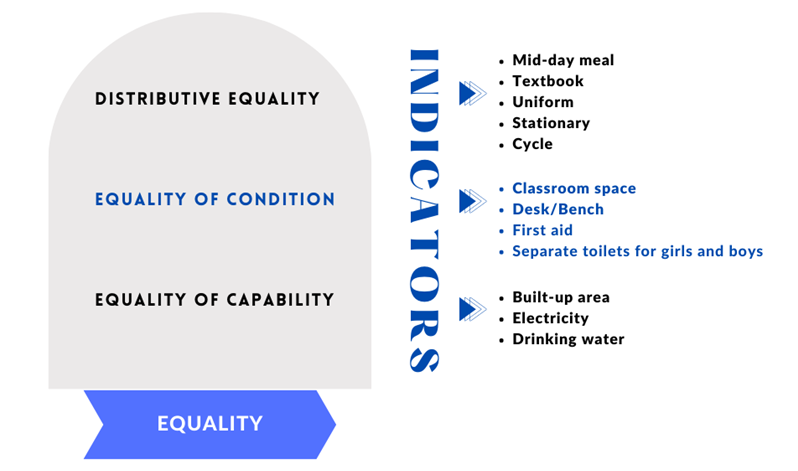
Gender equality, equity, and social inclusion (GESI) is an important global aspiration and a necessary condition for the achievement of many SDG targets. To ensure equitable and inclusive quality education for all by 2030, special attention needs to be paid especially to those who are marginalized. The Effectiveness and Scalability of Programs for Children Who Are Out of School and at Risk of Dropping Out in Bangladesh, Bhutan and Nepal project supported by the Global Partnership for Education Knowledge and Innovation Exchange, a joint endeavour with Canada’s International Development Research Centre, recognizes disparities in terms of gender equality and social inclusion among students as a key concern in public schools. Therefore, this project has developed a GESI diagnosis framework to examine gender and other social factors that undermine equality, equity and social inclusion in the context of public schools.
The conceptual framework has been derived from Amartya Sen’s capability approach and it comprises four major concepts of gender equality, equity, equality and social inclusion. Operational definitions, conceptual understandings and indicators associated with these variables are based on the contributions of Unterhalter (2009), Melanie Walker (2007), and Mario Briggeri (2004). This GESI framework supports inclusive policies and strengthens the influence of excluded groups.
Using this framework, the project studies public schools in two remote and rural districts in Nepal. The diagram below represents the framework used:

This blog elaborates on the four major concepts of this framework, including theoretical references and relevant indicators.
Gender equality is measured using the concepts of participation, bodily integrity, resources and respect based on Walker’s list of capabilities, and indicators were set for each theme. For instance, indicators to measure and evaluate equal participation of boys and girls in teaching and learning activities include asking questions to teachers in the classroom, participating in question-answer sessions, raising hands, and participating in sports and training. Similarly, indicators such as safety concerns of boys and girls at the school, and instances of violence and harassment, experiences of bullying from friends, and corporal punishment measure and evaluate bodily integrity. Indicators to evaluate gender equality in terms of access to resources include the availability of separate toilets for girls and boys, provision of sanitary pads, and amenities inside toilets. Finally, to measure respect, factors such as discrimination based on gender, greetings from teachers, and dignified treatment were identified as core indicators.

Equity in education is conceptualized in three dimensions of equity from above, equity from middle and equity from below based on Elaine Unterhalter (2009). Equity from above considers government policies and programs, such as the provision of free higher education for people with disabilities or from economically disadvantaged families. Equity from the middle is associated with the movement of resources – ideas, time, money, skill, etc. – that facilitate learning. Equity from below considers students’ participation in schools through activities such as negotiation, discussion, and questioning.

Equity from above was measured through indicators such as compulsory and free education, mid-day meal programs, scholarship programs, and mother tongue-based multilingual education. Equity from the middle was measured through the quality of resources provided by stakeholders. The distribution of resources is measured with reference to different levels of caste, class, ethnicity, religion, and gender. Equity from below was measured with reference to “voice”. Here, voice indicates the participation of students in the school. It is measured through different indicators such as participation in question-answer sessions and raising hands among rural students from different castes, classes, ethnicities, religions and genders.
Equality is measured with reference to Elaine Unterhalter’s three dimensions of equality in education: distributive equality, equality of condition, and equality of capability. The distributive dimension examines the distribution of goods and services that ensure equality in education. For this purpose, indicators included the distribution of mid-day meals, textbooks, uniforms, stationary, and bicycles. Equality of condition examines the enabling environment for each individual. The condition of community schools was assessed through indicators such as the availability of classroom space and desks/benches, as well as safety and hygiene, including separate toilets for girls and boys. The equality of capability dimension is derived from the work of Amartya Sen. This concept evaluates social policy, including education, without ignoring individual aspirations or dictating social benchmarks. The framework explores whether students are provided with opportunities such as adequate buildings, electricity, and drinking water that help their effective functioning and support educational well-being.

Social inclusion can be examined through resources, participation, curriculum and freedom from economic and non-economic exploitation. These themes were derived from Mario Briggeri’s (2004) list of capabilities for evaluating inclusive participation of children in different educational settings with diverse socio-economic dimensions. To understand different levels of inclusion associated with available school resources, disabled-friendly infrastructure was selected as an indicator. This is an integral part of any inclusive environment. Without it, children living with disabilities cannot exercise their full capabilities, which in turn creates social exclusion.

Students’ participation in sports and training activities in relation to their economic background, caste, religion and gender, was also used to measure social inclusion. The level of inclusion associated with curricular activities was measured by the availability of Braille textbooks for children with visual impairments. In addition, indicators such as household chores and external responsibilities were used to measure freedom from economic and non-economic exploitation.
The GESI diagnosis framework is a simple and practical tool that can be used to study the various dimensions of gender equality, equity, and inclusion in schools or education systems. Below are some examples of how student community development projects have used the framework to generate focused data to address concerns in public schools in Yamuna Mai municipality in Rautahat district of Nepal.
- Gender (in)equality in Public Education: A study of Rural Community School in Nepal
- Conceptualizing and Examining Equity in Basic Education at Yamunamai Rural Municipality
- Girls and Education: Challenges that girls face in public schools in Rautahat
- Social Exclusion in Public Education in Yamunamai, Rautahat
